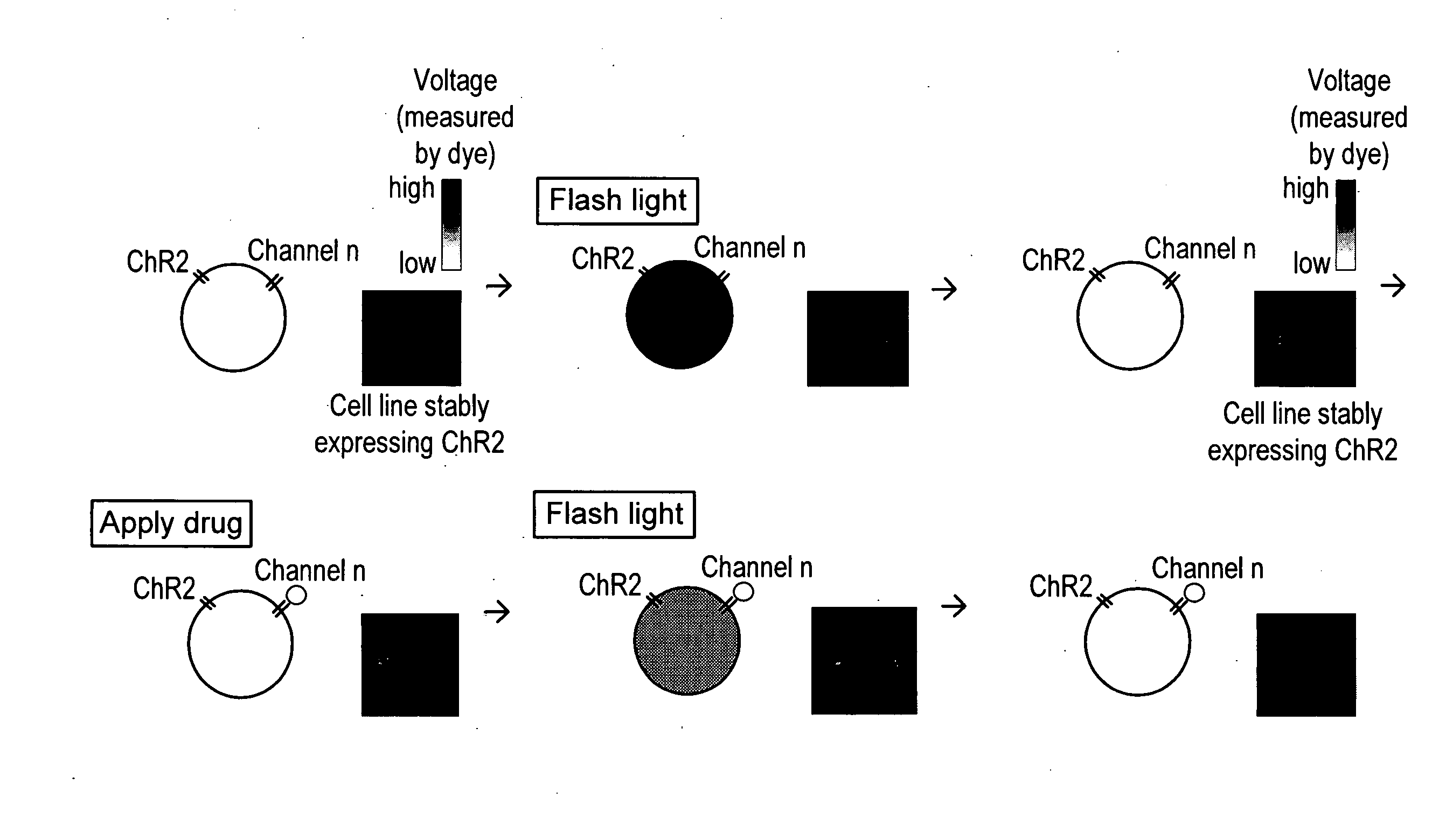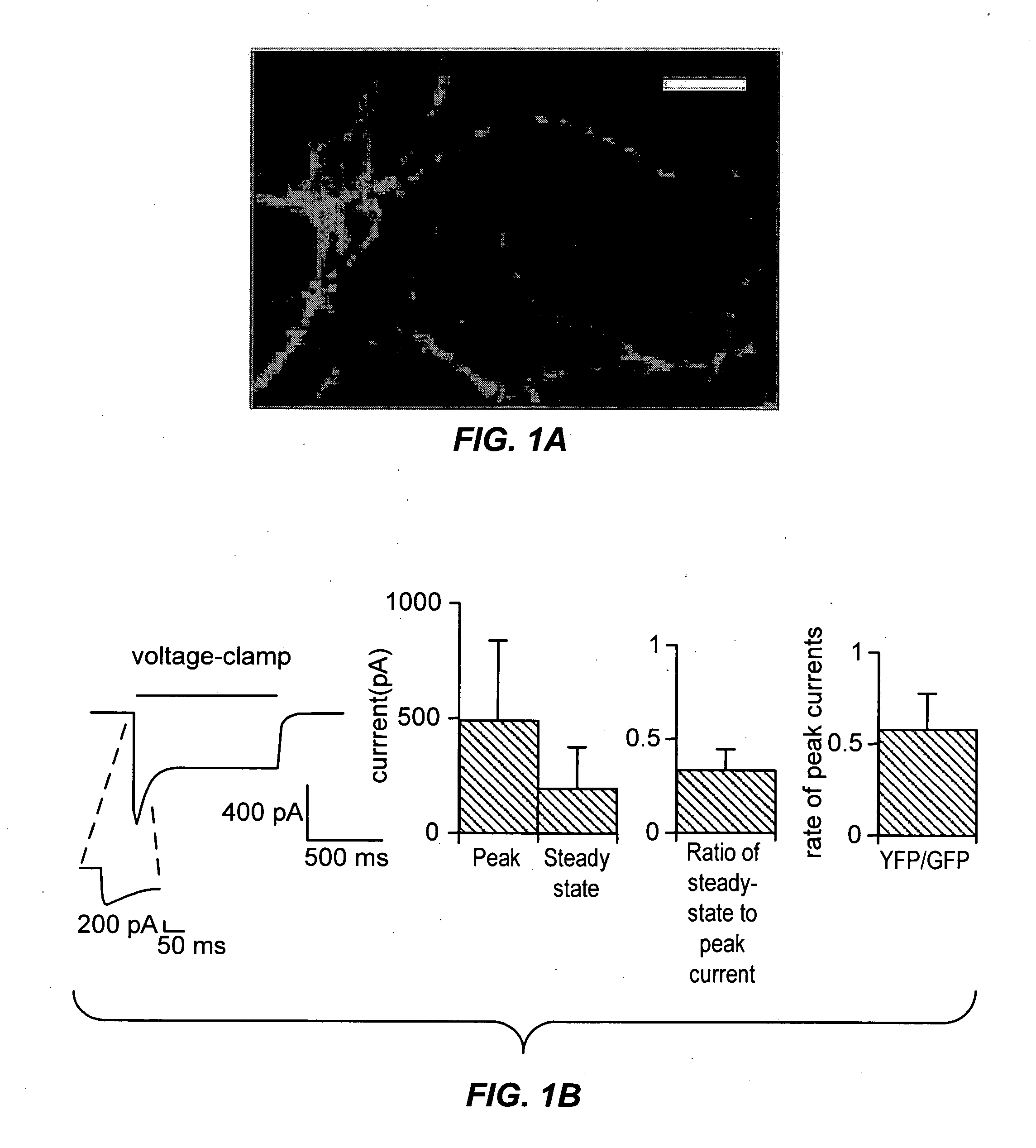Light-activated cation channel and uses thereof
a technology of cation channel and light-activated ion channel, which is applied in the field of light-activated ion channel proteins, can solve the problems of changing the voltage across the membrane, more difficult task to drive reliable and precisely sized subthreshold depolarization, and existing genetically-targeted approaches that require expensive, custom-synthesized exogenous compounds
- Summary
- Abstract
- Description
- Claims
- Application Information
AI Technical Summary
Benefits of technology
Problems solved by technology
Method used
Image
Examples
example 1
[0244] To obtain stable and reliable ChR2 expression for coupling light to neuronal depolarization, we constructed lentiviruses containing a ChR2—YFP fusion protein for genomic modification of neurons. Infection of cultured rat CA3 / CA1 neurons led to appropriately membrane-localized and well-tolerated expression of ChR2 for days to weeks after infection (FIG. 1a). There was no evidence of toxicity due to the expressed protein, even at high fusion protein expression levels. Whole-cell voltage-clamp recording of neurons showed that conventional GFP illumination in the bandwidth 450-490 nm (300 W xenon lamp (Sutter DG-4), via Chroma excitation filter HQ470 / 40x) induced depolarizing currents with fast rise rates—reaching a maximal rise rate of 160+111 pA / ms within 2.3+1.1 ms after the onset of the light pulse (mean ± standard deviation reported throughout, n=18; FIG. 1b, left). Mean whole-cell inward currents were large, 496 pA±336 pA at peak and 193 pA±177 pA at steady-state (FIG. 1b, ...
example 2
[0245] We examined whether ChR2 could drive actual depolarization of neurons held in current-clamp mode, with the same steady illumination protocol we used for eliciting ChR2-induced currents (FIG. 1d, left). Early in an epoch of steady illumination, single neuronal spikes were rapidly and reliably elicited (8.0+1.9 ms latency to spike peak, n=10; FIG. 1d, right), consistent with the fast rise times of ChR2 currents described above. However, for these cells, at these specific conditions, any subsequent spikes elicited during steady illumination were poorly timed (FIG. 1d, left). Thus, for this particular sample, steady illumination was not adequate for controlling the timing of ongoing spikes with ChR2, despite the reliability of the first spike. Earlier patch-clamp studies using somatic current injection showed that spike times were more reliable during periods of rapidly rising membrane potential than during periods of steady high-magnitude current injection. This is consistent wi...
example 3
[0246] We found that the single spike reliably elicited by steady illumination had extremely low temporal jitter from trial to trial (FIG. 1d, right; 0.5+0.3 ms; n=10 neurons). This observation led us to devise a pulsed-light paradigm, which takes advantage of the low jitter of the single reliable spike evoked at light pulse onset. But in order for such a pulsed-light paradigm to work, the conductance and kinetics of ChR2 would have to permit peak currents of sufficient amplitude, during light pulses shorter than the desired interspike interval. Indeed, using fast optical switching, we found that multiple pulses of light with interspersed periods of darkness could elicit reliable and well-timed trains of spikes (FIG. 1e; shown for 25 Hz trains of four pulses). FIG. 1e highlights the fact that longer light pulses evoke single spikes with greater probability than short light pulses. The ability to easily alter light pulse duration with fast optical switching suggests a straightforward...
PUM
| Property | Measurement | Unit |
|---|---|---|
| wavelength | aaaaa | aaaaa |
| wavelength | aaaaa | aaaaa |
| wavelength | aaaaa | aaaaa |
Abstract
Description
Claims
Application Information
 Login to View More
Login to View More - R&D
- Intellectual Property
- Life Sciences
- Materials
- Tech Scout
- Unparalleled Data Quality
- Higher Quality Content
- 60% Fewer Hallucinations
Browse by: Latest US Patents, China's latest patents, Technical Efficacy Thesaurus, Application Domain, Technology Topic, Popular Technical Reports.
© 2025 PatSnap. All rights reserved.Legal|Privacy policy|Modern Slavery Act Transparency Statement|Sitemap|About US| Contact US: help@patsnap.com



